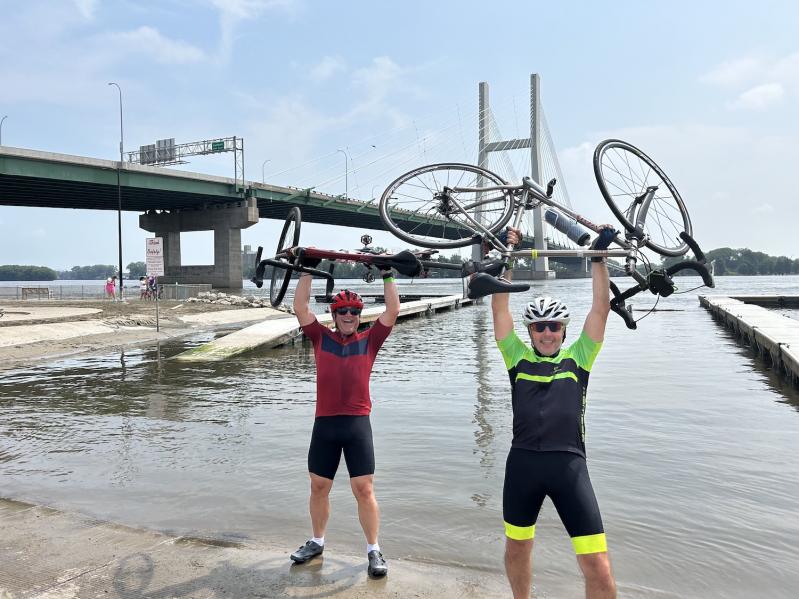Dropping his front bicycle tire into the Mississippi River on July 27, Bennett Schmidt had just completed a seven-day, 434-mile ride across the State of Iowa as part of the Register’s Annual Great Bicycle Ride Across Iowa, known as RAGBRAI.
Along the ride, Mr. Schmidt, who is originally from St. Louis but lives in East Hampton, encountered Civil War re-enactors, rode along the real-life Bridges of Madison County, and posed for a photo in the town where Grant Wood painted the 1930 work “American Gothic.”
“For me, it was one of the most challenging — grueling at parts — but challenging things I’ve ever done. And yet, it was one of the most exhilarating and euphoric when it was over,” Mr. Schmidt said last week.
This year was the 51st annual RAGBRAI, which draws thousands of participants from around the country. Every 15 or so miles, riders stop in pre-chosen towns for lunch, water, rest, and sometimes beer. At night, after between 40 and 85 miles of biking, riders arrive at a campground where they spend the night in a tent.
This year’s was the eighth shortest yet hilliest ride in RAGBRAI’s history, according to KCCI, a Des Moines news outlet.
The days typically began at 6. Mr. Schmidt would watch the sunrise from the hilly country roads.
“The sun was just coming up and it was kind of overcast and hazy. . . . You could look into the horizon and see hundreds of bikes going down a country road. It was a beautiful sight, in its own way,” he said.
By 9 a.m. each day, he’d spot his first beer stand. National brewing companies had vendors selling beer at roadside farmhouses, where hundreds of people would line up early in the morning, but Mr. Schmidt did not partake until he had completed the ride.
For lunch, riders stopped in small towns, which apply each year to be included in the route. A crew of food trucks — most selling variations of pork — followed the group. Many riders recommended that Mr. Schmidt eat at Mr. Pork Chop, a converted pink school bus which sold grilled pork chops. His favorite meal from the trip, however, was one which he described as “very Iowa” — a sausage on a stick, wrapped in a pancake.
Around 3 p.m. each day, Mr. Schmidt arrived at the campsite town, typically a county seat with “a lot of character” and an interesting history, Mr. Schmidt said. By the end of the day, the group had typically passed through seven or eight small Iowa towns.
Mr. Schmidt spoke to many riders along the way, meeting at least one from his hometown of St. Louis each day. Whenever a bike was pulled over on the side of the road, people would always stop to help, he said.
“Riding through these places, some of them, to be honest with you, were kind of sad,” Mr. Schmidt added. “They were towns of maybe 1,500 that you could see weren’t fully inhabited. Or you could see they were towns of 5,000 or 10,000 in their prime and they weren’t as robust as they once were. And you think: What’s going to fill them back up?”
Early in the ride, the group rode over covered bridges in Madison County, which were made famous in a 1995 movie directed by and starring Clint Eastwood, an adaptation of the book “The Bridges of Madison County” by Robert James Waller. In Eldon, the town where “American Gothic” was painted, locals provided riders with pitchforks so they could pose in the style of the iconic painting.
In Ottumwa, Mr. Schmidt saw an old synagogue which had been converted into a community center. The synagogue drew his attention, so Mr. Schmidt later researched the history of the building.
“You don’t really see that in rural areas. That was kind of astounding to me. And moving, personally,” he said.
While RAGRAI is not itself a charity ride, Mr. Schmidt raised money for Summer Camp Opportunities Promote Education, a nonprofit he is involved with that seeks to help children attend summer camps. Originally, his goal was to raise $4,500. In the end, he doubled his goal by raising almost $9,000, enough to send six children to summer camp next year.
To prepare, he followed the endurance course provided by the organizers of RAGBRAI. The program recommended RAGBRAI riders start by riding 10 miles per day. The number increased over time, until a rider could do 70 miles in a day.
“Endurance is really the key, it’s not so much the speed,” he said.
In East Hampton, Mr. Schmidt had difficulty finding the elevation necessary to adequately prepare, so he biked in the hilliest area he could find: the roads leading to the Montauk Lighthouse. By the end of his training, he could bike 65 miles a day on hilly terrain.
Completing the ride was a “second-tier bucket list” item, Mr. Schmidt said. He’d known about it since the 1980s, when a former boss, who was from Iowa, took part.
“As hokey as it sounds, it was very touching and partly nostalgic and partly emotional. I got very emotional,” Mr. Schmidt said about returning to the Midwest for the ride. He’d do it again, he said, but hesitates at the thought of having to sleep in a tent.







